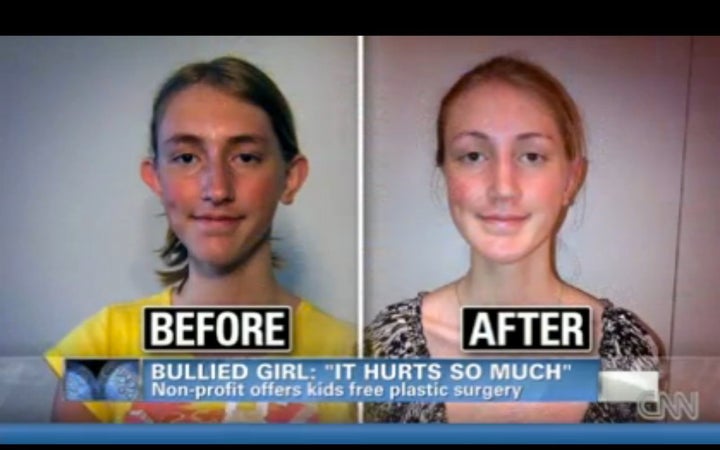
Bullying in on the minds of many and is a serious concern with lasting impact. We generally think of it as a psychological issue, but now it seems it has become a physical one, as well.
In an attempt to address this troublesome trend, the nonprofit organization Little Baby Face Foundation has gotten involved. Its mission is to provide free surgical repair to young children born with facial deformities (many of whom would otherwise be unable to afford these cosmetic procedures), giving them the "baby face" they deserve. Although it may have good intentions, what does it say when a charity like this offers its services to young teens seeking to avoid bullying? It seems to me that it fosters its own troublesome trend.
According to CNN reporter Sanjay Gupta, a young girl named Nadia Ilsa was called "Dumbo" for years growing up and was tired of being made fun of by her peers. She had what she described in her own words as "elephant ears" and, since the age of 10, had begged her mother for an operation to pin them back.
Her wish was granted by the Little Baby Face Foundation. Not only did the organization's founder, Dr. Thomas Romo, do work on her ears (otoplasty) but he suggested that her nose be reduced (rhinoplasty) and her chin be altered (mentoplasty) to achieve the best results. Nadia, although previously unaware that her other facial features needed correcting, eagerly followed Dr. Romo's recommendation and had all three procedures done. She just wanted to feel better about herself and was willing to do almost anything to avoid further emotional pain. Nadia, currently age 14, was shown her before-and-after photos and told CNN, "I look beautiful. This is exactly what I wanted. I love it." She felt that the post-surgical physical pain was well worth the transformation she experienced.
For that young girl, it was a dream come true; a little nip and tuck and an unhappy, awkward teen was magically transformed into a beautiful swan. But what are we really saying here? Should victims of teasing bear the brunt of their bullying peers by making the transformations needed to avoid being tormented? Do we encourage our children to seek "normalcy" by going under the knife to achieve culturally deemed acceptable features, rather than teach kids to love themselves?
If requests for pinned-back ears or reduced noses are met (whether by a foundation or a private surgeon), what happens when our young teens want other features altered: larger eyes, higher cheekbones, bigger breasts, smaller waists, or longer legs? It seems like a slippery slope that is all too familiar to older men and women lining up in their plastic surgeon's offices for anti-aging procedures sought to keep them from losing face in our youth-obsessed culture.
The number of American teens receiving surgery in general is on a steep rise. According to American Society of Plastic Surgeons (ASPS), nearly 219,000 cosmetic surgeries were performed on people age 13 to 19 in 2010. More and more are seeking procedures upon graduating from high school so that they begin their college years with a fresh "look." No one will know them in their new environment, so no explanations are required for their altered looks. They believe these back-to-school surgical procedures will give them a leg up on social success and improve their self-esteem. These are troubling statistics, but using this solution to help victims of bullying is even more so.
My thought is that charities like Little Baby Face need to be reserved for children with serious facial deformities -- those born with genetic defects, like cleft palates, or kids who endure facial disfigurement as a result of trauma. Giving these children the opportunity to start life with a greater chance to be woven into society is different from standardizing the heterogeneity that is inherent in being human. There's a line to be drawn, and to me it's a pretty clear one.
A solution to bullying that involves surgical procedures (which have their own set of physical risks that few talk about) is a terrible message to give both bullies and their victims. Do we really think that changing physical features undoes the emotional damage created by being teased? And aren't we validating the very message behind bullies' actions, that diversity and variation is bad? We need to be encouraging young people to admire and embrace differences -- and that starts from an early age.
What do you think about teenage cosmetic surgery? Is it a potential solution for bullied kids or a dangerous trend?
* * * * *
Vivian Diller, Ph.D., is a psychologist in private practice in New York City. She serves as a media expert on various psychological topics and as a consultant to companies promoting health, beauty, and cosmetic products. Her book Face It: What Women Really Feel As Their Looks Change (2010), edited by Michele Willens, is a psychological guide to help women deal with the emotions brought on by their changing appearances.
For more information, please visit her website at VivianDiller.com, and continue the conversation on Twitter: @DrVDiller.